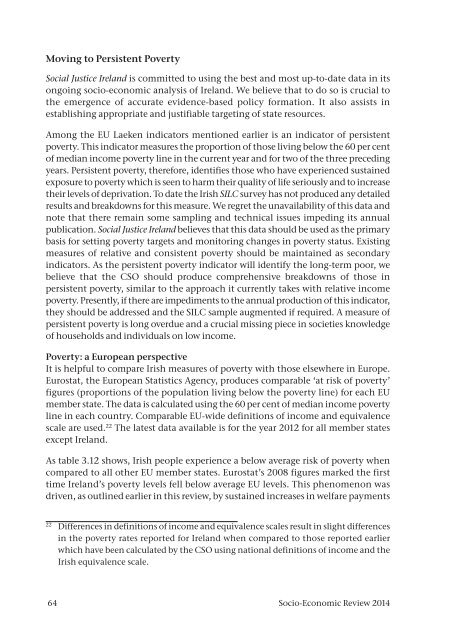2014-04-22 - Socio Economic Review 2014 - Full text and cover - FINAL
2014-04-22 - Socio Economic Review 2014 - Full text and cover - FINAL
2014-04-22 - Socio Economic Review 2014 - Full text and cover - FINAL
Create successful ePaper yourself
Turn your PDF publications into a flip-book with our unique Google optimized e-Paper software.
Moving to persistent poverty<br />
Social Justice Irel<strong>and</strong> is committed to using the best <strong>and</strong> most up-to-date data in its<br />
ongoing socio-economic analysis of Irel<strong>and</strong>. We believe that to do so is crucial to<br />
the emergence of accurate evidence-based policy formation. It also assists in<br />
establishing appropriate <strong>and</strong> justifiable targeting of state resources.<br />
Among the EU Laeken indicators mentioned earlier is an indicator of persistent<br />
poverty. This indicator measures the proportion of those living below the 60 per cent<br />
of median income poverty line in the current year <strong>and</strong> for two of the three preceding<br />
years. Persistent poverty, therefore, identifies those who have experienced sustained<br />
exposure to poverty which is seen to harm their quality of life seriously <strong>and</strong> to increase<br />
their levels of deprivation. To date the Irish SILC survey has not produced any detailed<br />
results <strong>and</strong> breakdowns for this measure. We regret the unavailability of this data <strong>and</strong><br />
note that there remain some sampling <strong>and</strong> technical issues impeding its annual<br />
publication. Social Justice Irel<strong>and</strong> believes that this data should be used as the primary<br />
basis for setting poverty targets <strong>and</strong> monitoring changes in poverty status. Existing<br />
measures of relative <strong>and</strong> consistent poverty should be maintained as secondary<br />
indicators. As the persistent poverty indicator will identify the long-term poor, we<br />
believe that the CSO should produce comprehensive breakdowns of those in<br />
persistent poverty, similar to the approach it currently takes with relative income<br />
poverty. Presently, if there are impediments to the annual production of this indicator,<br />
they should be addressed <strong>and</strong> the SILC sample augmented if required. A measure of<br />
persistent poverty is long overdue <strong>and</strong> a crucial missing piece in societies knowledge<br />
of households <strong>and</strong> individuals on low income.<br />
poverty: a European perspective<br />
It is helpful to compare Irish measures of poverty with those elsewhere in Europe.<br />
Eurostat, the European Statistics Agency, produces comparable ‘at risk of poverty’<br />
figures (proportions of the population living below the poverty line) for each EU<br />
member state. The data is calculated using the 60 per cent of median income poverty<br />
line in each country. Comparable EU-wide definitions of income <strong>and</strong> equivalence<br />
scale are used. <strong>22</strong> The latest data available is for the year 2012 for all member states<br />
except Irel<strong>and</strong>.<br />
As table 3.12 shows, Irish people experience a below average risk of poverty when<br />
compared to all other EU member states. Eurostat’s 2008 figures marked the first<br />
time Irel<strong>and</strong>’s poverty levels fell below average EU levels. This phenomenon was<br />
driven, as outlined earlier in this review, by sustained increases in welfare payments<br />
<strong>22</strong><br />
Differences in definitions of income <strong>and</strong> equivalence scales result in slight differences<br />
in the poverty rates reported for Irel<strong>and</strong> when compared to those reported earlier<br />
which have been calculated by the CSO using national definitions of income <strong>and</strong> the<br />
Irish equivalence scale.<br />
64 <strong>Socio</strong>-<strong>Economic</strong> <strong>Review</strong> <strong>2014</strong>



